Say hip hop and East Harlem-born Tupac Shakur may come to mind, not Royal S, Chyno, or Malikah, whose Beirut, Lebanon presence has morphed from a trend to a culture.
MC/beat maker Chyno associates this art form with Beirut youth’s frustration at the lack of outlets like city parks, sports facilities, and healthy escapes in a country engrossed in politics and corruption.
“There’s break dance, b-boying, there’s rap. It’s an art form that encompasses so much,” he said, explaining how youth like letting off steam.
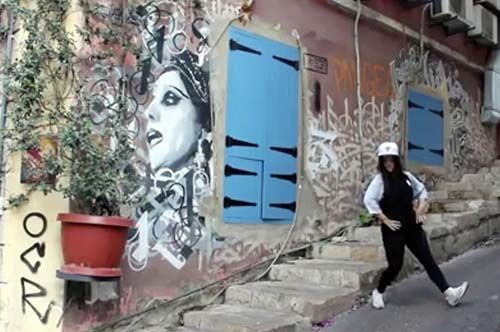
Screen shot of Beirut b-boying
He and a slew of hip hop, rap, dance, graffiti and other artists are featured in Salim Saab’s maiden voyage into documentary making, “Beyrouth Street: Hip Hop au Liban,” premiering today.
The film’s premiere comes as an act of defiance at Lebanon’s political/sectarian establishment in an ironic coincidence on April 13, marking the start of the 15-year Lebanese civil war in 1975.
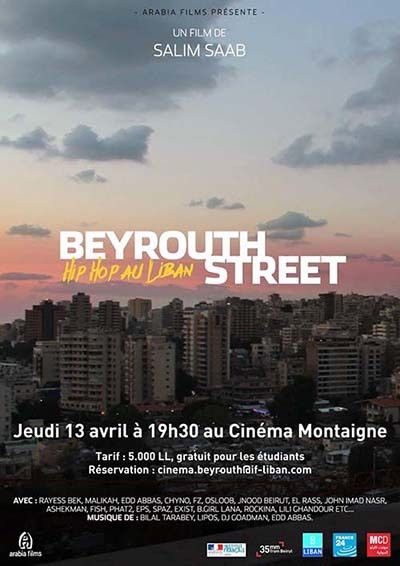
Beyrouth Street: Hip hop au Liban poster (courtesy Saab)
“I wanted to show the Lebanese hip hop movement, to show that there are a lot of talented people in this country, a rich underground movement,” Saab told me. “I also wanted to show another Beirut; it’s also a tribute to Beirut.”
Saab, who hosts a culture show on Monte Carlo Doualiya – the France-based Arabic-language arm of Radio Monte Carlo – also goes by the name of Royal S and raps in French and Arabic.

Radio host/documentarist Salim Saab (courtesy Radio Monte Carlo)
His film adventure took him three months to shoot and about four to edit, using just one Canon 650D camera, two lenses, and no light, and admits the uneven definition was due to his single-handed effort.
But Saab managed to come up with 54:30 rich minutes of scenes, music, street panoramas and explanatory conversations with artists spanning a range of forms and interests.
The stars featured in the film boast noms-de-rap (or hip hop) like Rayess Bek, Edd Abbas, FZ, Spaz, Osloob, El Rass, Fish, Double A, and Lethal Skills, to name a few.
“I was 18 when I began dancing. Dance is a way of expression. In the final analysis, we want a means to vent off,” said B Girl Lana, one of the film’s subjects. “My parents were very supportive, which I didn’t expect.”
Another unlikely female figure is Malikah, a Lebanese-Algerian rapper who said Arabic rap was still new and that as a culture in Lebanon and Arab countries it was in its early growing stages.
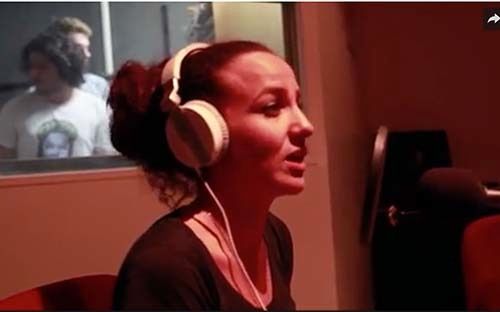
Screen shot of Malikah, a Lebanese-Algerian rapper
“I began rapping in 2000, first in French, even a bit in Spanish, but in 2006, switched to Arabic,” she said. “It’s a beautiful language, from that day on, I decided I’d rap in my own language, like the French rap in French and the Americans rap in English.”
Not all artists in the film are Lebanese. Osloob (Arabic for style) is a Palestinian and a product of the Burj El Barajneh refugee camp. He found his calling in rap, and went on to greener pastures in France.

Screen shot of Palestinian rapper Osloob (Style)
For Ribal Rayess of the online Radio Beirut, it was important to give voice to all artists in Lebanon, including the outspoken hip hop community.
“It’s the nature of the beast, it’s poetry, it’s social criticism, it’s something we really need in Beirut since we’re the capital and the nerve center,” he said in a sequence of the documentary.
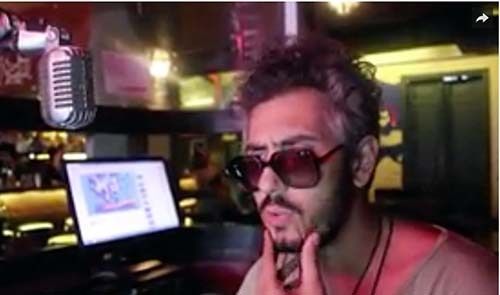
Screen shot of Radio Beirut's Ribal Rayess
He added that Radio Beirut had never censored hip hop and was grateful that in Lebanon there’s more freedom of expression than other countries, despite other hassles.
Saab’s forays include a brief tour d’horizon of Beirut’s graffiti scene, which has grown exponentially in recent years.
According to graffiti artist Phat2, there’s a lot of street art, portraits of famous people, political issues, but he and his colleagues are also trying to push the artistic scene to more professional work than amateurish endeavors that dot the cityscape, to reach what he termed European and American standards.
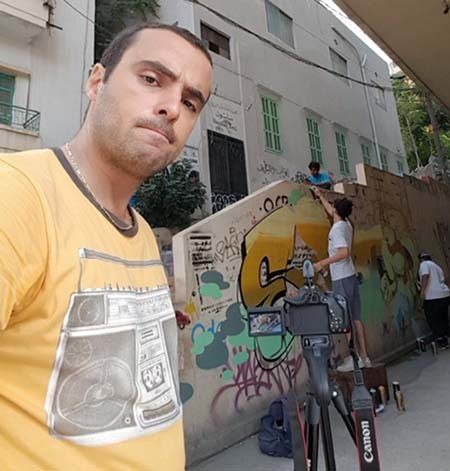
Saab selfie with Beirut graffitti artists (courtesy Saab)
“I’m drawing calligrafiti,” said artist Omar Kabbani who mixes Arabic calligraphy with graffiti and was working on a design of composer/performer Ziad Rahbani and his famous musical “Bil Nisbeh La Boukra Shou?” (What About Tomorrow?)
Kabbani equated Rahbani with Tupac in Lebanon.
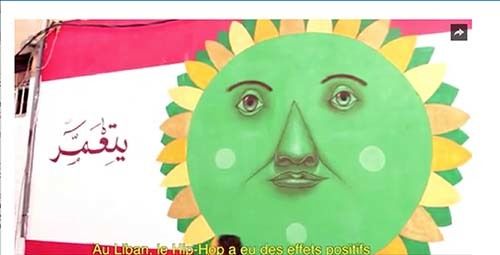
Screen shot of Beirut hip hop and graffiti scene
I asked Saab why he mixed French and English in the film’s title. Beyrouth is the French spelling for the Lebanese capital and street is, obviously, an English word.
“I didn’t mix it,” he replied. “‘Beyrouth Street’ is also a tribute to the movie ‘Beat Street,’ plus in France everybody says the word ‘street’ like ‘weekend’ or ‘hello.’”
Saab, who graduated from Paris’ Ecole Supérieur de Journalisme, worked for magazines and online media before turning to radio.
